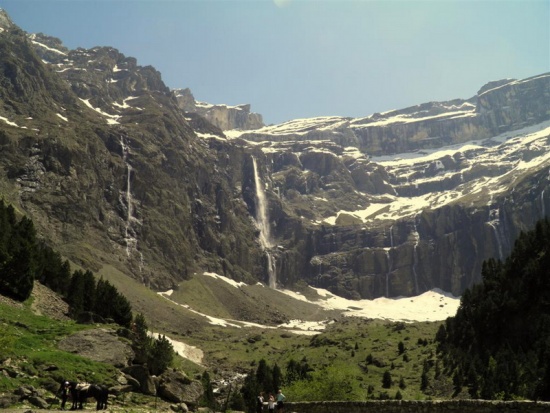
The Cirque de Gavarnie, with the highest waterfall in Europe, with an overall drop of 422 metres, Pyrenees National Park
Overview
Extending more than 100km along the the French-Spanish border from the valley of the Aspe to that of the Aure, and less than 15km wide, this park protects a long narrow stretch of the Pyrenees, including the 3298m Vignemale.
In all the park covers more than 45000ha of land mainly between 1000 and 3000m altitude. One of the most popular destinations of this area is the glacially-formed Cirque de Gavarnie the edge of which meets the border and adjoins Spain's Ordesa National Park.
Botanists are attracted to the park by the numerous gentians and saxifrages among the park's flora and there is a special nature reserve, Neouvielle, in the east of the park which has several beautiful lakes and unusually high altitude stand of Mountain Pine Pinus mugo subsp. uncinata.
Birds
Notable Species
Birds of this area include most of the typical Pyrenean species and Wallcreeper is frequently seen here. Raptors are a speciality of this park and include Golden Eagle and Bonelli's Eagle, Griffon Vulture and Egyptian Vulture and the extremely rare Lammergeier.
Other birds include typical mountain species such as Wallcreeper, Alpine Accentor and Snow Finch. The forests hold Eurasian Eagle Owl and Black Woodpecker, Crested Tit and Citril Finch.
Check-list
Birds you can see here include:
European Honey Buzzard, Black Kite, Red Kite, Short-toed Eagle, Western Marsh Harrier, Lammergeier, Egyptian Vulture, Griffon Vulture, Eurasian Goshawk, Eurasian Sparrowhawk, Common Buzzard, Golden Eagle, Booted Eagle, Bonelli's Eagle, Peregrine Falcon, Rock Ptarmigan, Western Capercaillie, Grey Partridge, Feral Pigeon, Great Eagle Owl, Tawny Owl, Alpine Swift, Black Woodpecker, Tree Pipit, Water Pipit, Grey Wagtail, Common Dipper, Common Wren, Dunnock, Alpine Accentor, Eurasian Robin, Black Redstart, Northern Wheatear, Rufous-tailed Rock Thrush, Ring Ouzel, Eurasian Blackbird, Mistle Thrush, Blackcap, Garden Warbler, Western Bonelli's Warbler, Common Chiffchaff, Willow Warbler, Goldcrest, Common Firecrest, European Pied Flycatcher, Coal Tit, Crested Tit, Blue Tit, Great Tit, Eurasian Nuthatch, Wallcreeper, Common Treecreeper, Common Jay, Alpine Chough, Red-billed Chough, Northern Raven, White-winged Snow Finch, Chaffinch, European Serin, Citril Finch, European Greenfinch, Eurasian Siskin, Eurasian Linnet, Common Crossbill, Common Bullfinch, Rock Bunting, Cirl Bunting, Yellowhammer
Other Wildlife
Mammals include Pyrenees Chamois Rupicapra pyrenaica and Wild Boar Sus scrofa, Marmot Marmota marmota and Red Squirrel Sciurus vulgaris, Pine Marten Martes martes, Red Fox Vulpes vulpes, Badger Meles meles and Otter Lutra lutra, Stoat Mustela erminea and Weasel Mustela nivalis. The elusive Genet Genetta genetta occurs here, and an Iberian speciality, the Pyrenean Desman Galemys pyrenaicus, is found in clean and clear mountain streams.
The Pyrenean Brown Bear Ursus arctos pyrenaicus is still found in the park but numbers are now extremely low and they are seen very rarely.
Pyrenean or Seoane's Viper Vipera seoanei, rare and restricted in range, is found in the Neouvielle Reserve.
Two restricted butterflies also occur here, the Glandon Blue Agriades glandon and Gavarnie Blue Agriades pyrenaicus, as well as more widespread species such as the Apollo Parnassius apollo.
Site Information
History and Use
The Pyrenees National Park was created in 1967 and is one of the seven French national parks. The central zone (457 sq km) is subject to special protection, but the peripheral zone (2063 sq km), has 86 villages, with 40,000 inhabitants, so it also falls under its responsibility regarding local life. The Ossau Nature Reserve is found in the central zone.
Areas of Interest
The cliffs near Aste-Beon are the site of a "vulture restaurant" where winter carrion is laid out for the birds. This has led to an increase in numbers and range of the vultures in this area.
Access and Facilities
The park has several roads and marked hiking trails, information and exhibition centres, and a botanical garden at Gavarnie. Accommodation is available at mountain refuges within the inner zone of the park (in summer only), and in hotels, guest houses and campsites in the outer zone. Many roads in the area are blocked by snow until May.
Contact Details
Comité Régional de Tourisme d'Aquitaine
4/5 Place Jean Jaurès - CS 31759
33074 Bordeaux cedex
Tel: +33 (0)5 56 01 70 00
Email: tourisme@tourisme-aquitaine.fr
External Links
- Pyrenees National Park website (in French)
- Aquitaine Tourism: Pyrenees National Park
- Pyrenees National Park on Google Maps
Content and images originally posted by Steve
Reviews
manucazier's review:
Local birdwatchers will be able to give you some good information... Rare species a Bearded vulture could be quite easy to see in Aspe Valley (around Bedous). Do not go there just to see a bear, they could be present but won't let you see anything of their life... Pros
- Landscapes
- many birds of prey...
Cons



